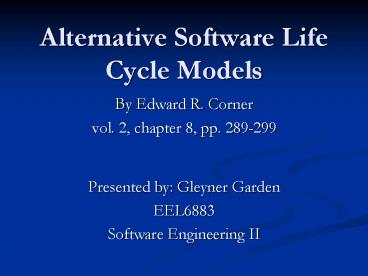Alternative Software Life Cycle Models - PowerPoint PPT Presentation
1 / 18
Title:
Alternative Software Life Cycle Models
Description:
Views the software life cycle as a set of prototypes that are evolved through ... new requirements which must be met to meet expectations. Project gets behind ... – PowerPoint PPT presentation
Number of Views:42
Avg rating:3.0/5.0
Title: Alternative Software Life Cycle Models
1
Alternative Software Life Cycle Models
- By Edward R. Corner
- vol. 2, chapter 8, pp. 289-299
Presented by Gleyner Garden EEL6883 Software
Engineering II
2
Feel free to interrupt!
3
Introduction
- The classic waterfall model that we are familiar
with was developed around 1970 by Dr. Winston
Royce - Many different models have been proposed since
then - They all exist to help cope with the great
complexity and expense of software products, and
to help create a product that meets the users
needs and expectations
4
Definition
- Not a definition of process followed by a
software development organization - Not a methodology
- Is a reference model for a software development
process that provides - a common basis for standards, and where these
standards belong with respect to the model - a description of major functions involved in
software development - insight towards the important aspects or features
necessary for common understanding and focus
5
Alternative Models
- Rapid, Throwaway Prototype
- Gomaa and Scott made it popular in 1981
- Focuses on ensuring product meets users needs
- Goal is to improve the quality of requirements
specifications by providing a quick and dirty
partial implementation during requirements phase - Use of this implementation by the users can
expose miscommunications in the requirement
specifications
6
Alternative Models
- Incremental Development
- Constructing a partially implemented, yet useful
build and then incrementally added functionality - Requirements can be defined for each increment in
advance, or during development between increments - If done correctly, can increase reliability and
decrease risk - Requires a very flexible system architecture, and
especially if the overall end-result is not fully
planning for
7
Alternative Models
- Evolutionary Prototypes
- Views the software life cycle as a set of
prototypes that are evolved through iterative
experimentation and refinement - Intended to addresses customer satisfaction
- Sort of a mixture of Rapid Prototyping and
Incremental Development, without the need for a
full understanding of requirements - Hard to scale up to large systems
- Expensive to use for complex mission-critical
applications
8
Alternative Models
- Reusable Software
- Reduce costs by incorporating existing designs,
programs, modules, and data into new software
products - Compatible with all life cycle models
- Avoid reinventing the wheel
- Less schedule needed, since code is already
written, and less bugs to fix, since software has
been proven
9
Alternative Models
- Automated Software Synthesis
- Automated transformation of formal requirements
into operational code - Relies heavily on automated tools (very smart
compilers)
10
Evaluation of Alternative Life Cycle Models
- Users needs are constantly evolving
- Creates new requirements which must be met to
meet expectations - Project gets behind schedule
- Waterfall example shows how development is
affected
11
Evaluation of Alternative Life Cycle Models
- Shortfall is a measure of how far the system at a
given time t, is from meeting the actual
requirements at time t - Lateness is a measure of the time that elapses
between the appearance of a new requirement and
its satisfaction - Adaptability is the rate at which the software
solution can adapt to new requirements - Longevity is the time a system solution is
adaptable to change and remains viable - Inappropriateness captures the behavior of the
shortfall over time (area between needs and
actual capabilities
12
Evaluation of Alternative Life Cycle Models
- Rapid Prototyping
- Increases likelihood that customers and
developers are on the same page at time t0 - At t1 the delivered function is higher for the
rapid prototyping approach - Shows overall, that function is closer to needs
than the waterfall model
13
Evaluation of Alternative Life Cycle Models
- Incremental Development
- Deliberately built to satisfy fewer requirements
initially, but facilitates incorporation of new
requirements which increases adaptability - Initial development time is reduced because of
limited functionality - Software can be enhanced more easily for a longer
period of time - Stair steps show series of well-defined, planned,
discrete builds of the system
14
Evaluation of Alternative Life Cycle Models
- Evolutionary Prototypes
- Number and frequency of operational prototypes is
increased - Initial prototype emerges rapidly to provide a
framework for the software - Each prototype explores a new area of user need,
while refining previous function - More adaptable
- Not stepped because we are introducing new
functionality with more refined old functionality
15
Evaluation of Alternative Life Cycle Models
- Reusable Software
- Potential to significantly decrease initial
development time - Only development time is different here
16
Evaluation of Alternative Life Cycle Models
- Automated Software Synthesis
- Development time is greatly reduced
- Development costs are reduced so much that
adapting old systems is not as good as
re-synthesizing the entire system - Low longevity, but very low shortfall
17
Defining, Selecting, or Adapting a Life Cycle
Model
- Life cycle model evaluation provides insight as
to how we might define, select, or adapt a life
cycle model to improve our process - Points that should affect selection
- Requirements volatility (likelihood that
requirements will change - The way that requirements change (big jumps,
gradually) - The longevity of the application
- The availability of resources to develop or
effect changes it may be easier to get resources
up front than to devote significant resources for
enhancements
18
Conclusion
- It was a very good paper that describes and
evaluates several different life cycle approaches - I would have liked to know if he used any real
data to get a general idea as to what the
different evaluation plots looked like































